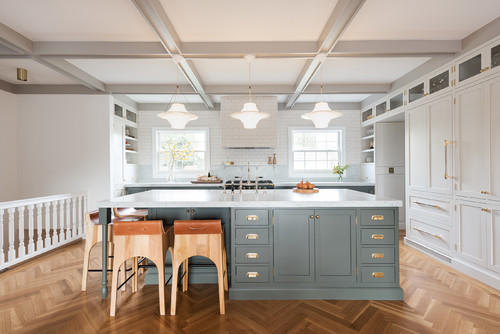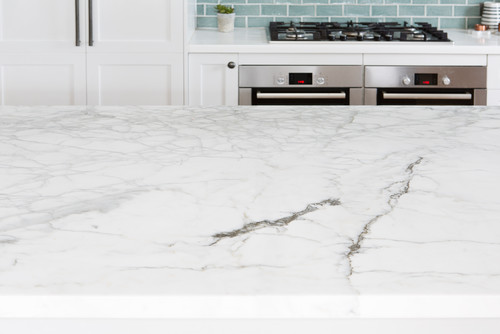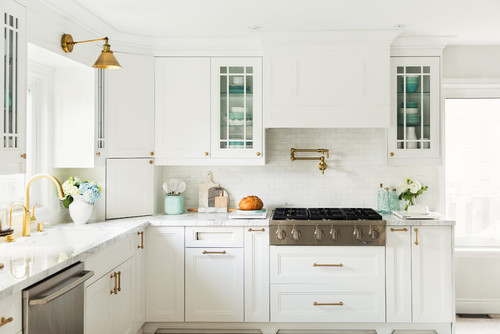 Transitional style is a highly coveted kitchen look, and yet many people don’t even know how to define it, let alone put it together on their own. This not-quite-modern, not-quite-traditional style has lots of room for self-expression, but there are common elements you can rely on to guide your design process. Take a peek at my design recipe to learn some of the most essential elements of transitional style, and you’ll be ready to create a formula all your own.
Transitional style is a highly coveted kitchen look, and yet many people don’t even know how to define it, let alone put it together on their own. This not-quite-modern, not-quite-traditional style has lots of room for self-expression, but there are common elements you can rely on to guide your design process. Take a peek at my design recipe to learn some of the most essential elements of transitional style, and you’ll be ready to create a formula all your own.The Basics: Mixing Old and New
Fundamentally, transitional style is all about balancing traditional and contemporary elements to achieve an elegant style that doesn’t feel too stuffy or minimalist.
Often this means taking evocative traditional shapes and applying a contemporary finish to them. For example, take a look at this beautiful bridge faucet. It’s a very traditional style of faucet, but when used in an au courant brass finish (as opposed to, say, a rustic blackened bronze), it feels quite contemporary.
Essential: Shaker Cabinets
Perhaps the best example of this balancing of traditional and contemporary elements is the Shaker style cabinet front.
These cabinet doors and drawers typically have a flat panel in the middle with a raised flat border at the edges and no “profiling” (i.e., no fancy curved molding). This gives a bit more richness than a minimalist flat-front cabinet without feeling fussy.
Cabinets in this style would have traditionally been wood toned, as built by the original Shakers, but they achieve a nice balance of old and new when painted in a crisp, contemporary shade.
The Palette: White and Gray with Neutrals
White Shaker cabinets are not seen in every transitional kitchen, but they are certainly a popular pick. This is likely because the freshness of white instantly makes any space feel more spacious.
Again, transitional kitchens are not strictly minimalist either, so the white is usually mixed with grays, woods, enticing metallics and other neutrals and textural elements for a friendly palette.
Dark and charcoal grays are quite popular as well, either instead of white cabinets or added alongside white for a tuxedo effect. Deep, true-neutral grays feel classic and sophisticated but also up-to-date.
For a fun twist, a dark gray chalkboard paint gives a room a sense of levity that keeps the mood from being too somber.
For those who prefer a bit more color, blue and blue-grays make a perfect hue for fixed elements like cabinets or floor tiles. This sort of color makes white porcelain and polished stone appear even more fresh, and it will work with changing accent hues in future years.
Essential: Rich Woods
Mixing these broad strokes of crisp paint with wood brings in much needed texture, so it’s very common to see transitional kitchens with wood floors, wood bar stools and butcher block counters.
Flooring planks in a herringbone layout bring additional richness, playing up the positives of traditional parquet floors in a way that doesn’t feel stuck in the past.
Sometimes the best way to use wood is unexpectedly, like as an accent on a vertical surface (like the side panels of a wall cabinet) or even on the ceiling. This brings in natural texture in a way that definitely won’t leave your space feeling as if it’s outdated.
Essential: Sparkling Stone
For quite a time, dark granite was widely seen as the top choice for counter-tops. But for a coveted transitional style, a lightly flecked or veined marble or quartz brings a mature sensibility without looking heavy. It’s just rich enough to suit the more traditional elements, but crisp enough to also work with contemporary accents. It’s great for all of the counters, or with a contrast stone or butcher block on an island for pleasing contrast.
Essential: Subway Tile
While we’re talking hard surfaces, here’s another key transitional style staple: subway tile. Whether you go for seamless off-white grout or a darker accent tone, humble white subway tile carries a timeless sense of elegance and simplicity, holding its own without fighting to be the star of the show.
Slab Back-splashes
That isn’t to say that subway tile is the only option, of course. Another very popular choice is to simply continue the counter material up the wall. This leans toward a more contemporary look, turning the counter and back-splash into a singular dramatic statement.
Mosaic Back-splashes
If you prefer the look of a mosaic back-splash, consider choosing one in a neutral palette in a rich, classic pattern rather than one in a trendy accent color. This is another great place to consider a herringbone installation or a tile with an interesting shape such as fish-scale or hexagon. This will suit the transitional style and help you avoid passing color trends in an area that’s not easy to update.
Essential: Stainless Steel
Stainless steel appliances are highly coveted but especially so in transitional kitchens, where they bring a chef’s-kitchen appeal and help integrate modern features into a somewhat traditional setting. Plus, adding some strong elements of crisp metal offsets the organic character of wood floors and stone counters. If you don’t currently have the budget (or the desire) to use stainless steel appliances throughout, consider using this finish for just one appliance like the range or through other accents like cabinet hardware.
Brass
Brass has recently been a very popular finish for transitional kitchen accents. It brings some golden glamour and warmth to a space but in a more subdued tone than true gold.
Feel free to mix it in beside stainless steel and other cool silvery metals. It makes for great knobs and pulls, lights or even fixtures.
Essential: Modern Furnishings
If you stick to just traditional trappings, you might end up with a kitchen that slides from transitional to just traditional overall. This is where some great modern furniture pieces come in, such as high-tech extruded dining chairs, mid-century bent metal bar-stools, cool industrial accent lights or a minimalist dining table.
Splurge: Statement Pendants
Your lighting is a great place to splurge, as it always makes for a natural center of attention. In transitional style, it’s very common to see sizable lights in a simple material and shape, relying on the drama of their size to catch your eye without being so bold as to overwhelm your field of vision when you sit down to snack.
Humble schoolhouse, dome or cone shapes are popular, as are glass globes or lantern-style fixtures. Like most of the other elements described here, they carry a subtle, traditional air without being fussy or too ornate.
You can use the lights as an opportunity to introduce a new accent material or color, such as a hint of red or copper, or match them to another finish in the space. These cone pendants pair nicely with the base of the stools.
Finishing Touch: Traditional Rug
As a tailor-made finish to your transitional space, a warm, colorful traditional rug will make sure it doesn’t feel too staid, bringing a splash of personality and sense of relaxed confidence. Try a runner placed alongside your island or even in the main work-spaceq, or a full rug anchoring an eat-in kitchen table.
















